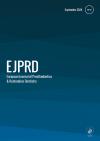European Journal of Prosthodontics and Restorative Dentistry
Long-Term Bonding Efficacy of CAD/CAM Hybrid Restorative Materials and Universal Adhesives
Abstract
Objectives: In-office and lab milled prostheses are the staple for indirect restorations. It is therefore critical to determine their long-term bonding durability. Methods: CAD/ CAM blocks of two classes of restorative materials: 1) a nano-ceramic reinforced polymer matrix (NCPM) and, 2) a polymer-infiltrated ceramic network (PICN) were bonded using four different universal adhesives (UA) and silane systems. A lithium disilicate glassceramic (LDS) was used as a reference. The blocks were bisected and bonded with different UA/resin-cement pairs. Bonded blocks were then cut into 1.0x1.0x12.0 mm bar specimens for microtensile bond testing. Half the bars were subjected to bond strength testing immediately and the other half after aging by 50,000 thermal cycles between 5°C and 55°C. ANOVA and post-hoc tests were used to compare mean bond strength among groups. Results: NCPM presented consistently high bond strength regardless of bonding techniques, while the bond strength of PICN and LDS were lower when bonded with UA relative to traditional silanes. The more hydrophilic UA produced higher bond strengths. Discussion: Glass-ceramics exhibited lower bond strength with UA than the conventional etch-rinse-silane techniques. However, UAs preserved bonding interface in the long-term. Significance: NCPM displayed superior bond strength relative to PICN and
LDS regardless of the type of adhesives and bonding techniques.
Keywords
Resin Cement
Polymer Infiltrated Ceramic Network
Microtensile Bond Strength
Universal Adhesives
Nano-Ceramic Reinforced Polymer Matrix
Glass-Ceramic
Authors
John Brewster, Nadin Al-Haj Husain, Mutlu Özcan, Parneet Gill, Malvin N. Janal, Yu Zhang
Articles from this issue
 Free Access
Free Access No Access
No Access Full Access
Full Access


